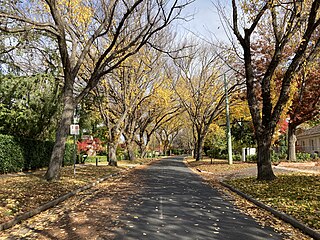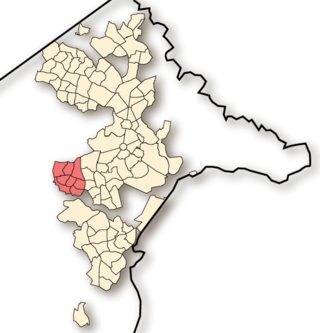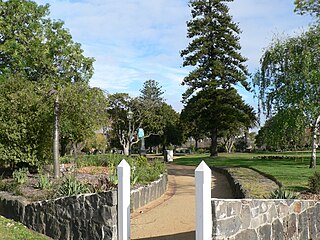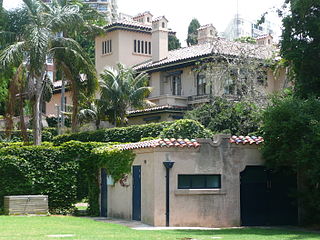
A shrubbery, shrub border or shrub garden is a part of a garden where shrubs, mostly flowering species, are thickly planted. The original shrubberies were mostly sections of large gardens, with one or more paths winding through it, a less-remembered aspect of the English landscape garden with very few original 18th-century examples surviving. As the fashion spread to smaller gardens, linear shrub borders covered up walls and fences, and were typically underplanted with smaller herbaceous flowering plants. By the late 20th century, shrubs, trees and smaller plants tend to be mixed together in the most visible parts of the garden, hopefully blending successfully. At the same time, shrubs, especially very large ones, have become part of the woodland garden, mixed in with trees, both native species and imported ornamental varieties.

Government House, in the suburb of Yarralumla, is the official residence of both the Australian monarch and his representative, the governor-general of Australia. It is located in the suburb of Yarralumla, in the City of Canberra, in the Australian Capital Territory. The house is set amid 54 hectares of parkland. The house and associated grounds were added to the Commonwealth Heritage List on 22 June 2004.

An arboretum is a botanical collection composed exclusively of trees of a variety of species. Originally mostly created as a section in a larger garden or park for specimens of mostly non-local species, many modern arboreta are in botanical gardens as living collections of woody plants and is intended at least in part for scientific study.

Yarralumla is a large inner south suburb of Canberra, the capital city of Australia. Located approximately 3.5 km (2.2 mi) south-west of the city, Yarralumla extends along the south-west bank of Lake Burley Griffin from Scrivener Dam to Commonwealth Avenue.

The Australian National Botanic Gardens (ANBG) is a heritage-listed botanical garden located in Acton, Canberra, in the Australian Capital Territory, Australia. Established in 1949, the Gardens is administered by the Australian Government's Department of Agriculture, Water and the Environment. The botanic gardens was added to the Commonwealth Heritage List on 22 June 2004.
Forrest is a suburb of Canberra, Australian Capital Territory, Australia. Forrest is named after Sir John Forrest, an explorer, legislator, federalist, Premier of Western Australia, and one of the fathers of the Australian Constitution. Streets in Forrest are named after explorers and governors. According to the Australian Bureau of Statistics Forrest is the second most Socio-Economic advantaged location in Australia after the neighbouring suburb of Barton.

Griffith is an early inner-south suburb of Canberra, Australian Capital Territory, Australia.

Weston Creek is a district in the Australian Capital Territory in Australia. The district is subdivided into divisions (suburbs), sections and blocks. The district comprises eight residential suburbs, situated to the west of the Woden Valley district and approximately 13 kilometres (8.1 mi) southwest of the Canberra City centre. Situated adjacent to the district was the large Stromlo Forest pine plantation until the forest was destroyed by bushfires in 2001 and 2003.

Old Parliament House, formerly known as the Provisional Parliament House, was the seat of the Parliament of Australia from 1927 to 1988. The building began operation on 9 May 1927 after Parliament's relocation from Melbourne to the new capital, Canberra. In 1988, the Commonwealth Parliament transferred to the new Parliament House on Capital Hill. It also serves as a venue for temporary exhibitions, lectures and concerts. The Old Parliament is in front of New Parliament Canberra

St Vincent Gardens in the Melbourne suburb of Albert Park, is an Australian park of national significance.

The Royal Botanic Garden, Sydney is a heritage-listed major 30-hectare (74-acre) botanical garden, event venue and public recreation area located at Farm Cove on the eastern fringe of the Sydney central business district, in the City of Sydney local government area of New South Wales, Australia.

Ainslie is a suburb of Canberra, Australia in the North Canberra district.

New Farm Park is a heritage-listed riverfront public park at 137 Sydney Street, New Farm, City of Brisbane, Queensland, Australia. It was designed by Albert Herbert Foster and built from 1914 to 1950 by Gladwin Legge & Co. It was added to the Queensland Heritage Register on 7 February 2005.

Constitution Place is a park in Canberra, the capital of Australia. The area was named in February 1998 by Prime Minister of Australia John Howard during the course of the Fourth Constitutional Convention on the options for an Australian republic. The park is located to the south-east of Old Parliament House and adjoining the Old Parliament House Gardens and nearby to the National Archives of Australia. It is semicircular in shape, with curved road frontages on King George Terrace, Walpole Crescent and Queen Victoria Terrace. There is also a windbreak of trees, which were planted by Charles Weston as superintendent of parks and gardens in Canberra.

The Ohio Governor's Residence and Heritage Garden is the official residence of the governor of Ohio. The residence was built during 1923–1925 by industrialist Malcolm D. Jeffrey and has served as the official home of the governor since 1957. The mansion is located at 358 North Parkview Avenue in Bexley, a suburb and enclave of the state capital, Columbus. It is only one of four official state governor's residences in the country that is not located within its state's capital.

Boomerang is a heritage-listed private house and garden located at 42 Billyard Avenue in the inner eastern Sydney suburb of Elizabeth Bay, in the City of Sydney local government area of New South Wales, Australia. The house was designed by Neville Hampson and the gardens and grounds by Max Shelley, and built from 1926 to 1928.

Ithaca Embankments is a heritage-listed group of embankments in the former Town of Ithaca and now in the suburbs of Kelvin Grove, Red Hill and Paddington in Brisbane, Queensland, Australia. They were designed by Alexander Jolly and built from c. 1917 to c. 1923. They were added to the Queensland Heritage Register on 2 March 1993.

Thomas Park Bougainvillea Gardens is a heritage-listed former private garden and now public park at 151 Harts Road, Indooroopilly, City of Brisbane, Queensland, Australia. It was designed by Henry Thomas and built from 1914 to 1918. It was added to the Queensland Heritage Register on 10 October 2014.

Mahratta is a heritage-listed former residence and bank executive training facility and now childcare centre, primary school and community group headquarters at 1526 Pacific Highway, Wahroonga, Ku-ring-gai Council, New South Wales, Australia. It was designed by Douglas S. Agnew, Arthur Palin and Paul Sorensen (garden) and built in 1941. It is also known as Mahratta and Site and Heatherlee. The property is owned by The School of Philosophy. It was added to the New South Wales State Heritage Register on 2 April 1999.




















